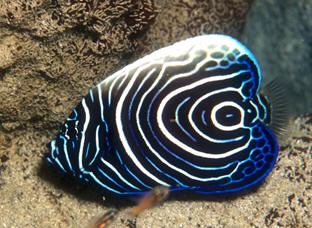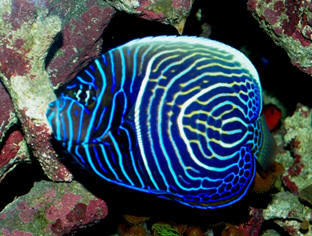|
Related FAQs:
Imperator Angelfish,
Emperor Angels 2,
Emperor Angels 3,
Emperor Angel ID,
Emperor Behavior,
Emperor Compatibility,
Emperor Angel
Selection, Emperor
Angel Systems, Emperor Feeding,
Emperor Disease,
Emperor Disease 2,
Marine Angelfishes In General,
Angelfish ID,
Selection,
Behavior,
Compatibility, Systems,
Health,
Feeding,
FAQs on Emperor Angel Health:
Emperor Disease 1,
Emperor Disease 2,
Emperor Health 3, Emperor Health 4,
Emperor Health 5, Emperor
Health ,
FAQs on Emperor Angel Health by Category:
Diagnosis,
Environmental,
Nutritional,
Pathogenic (see also:
Angels and Butterflyfishes & Crypt), Social,
Trauma,
Genetic,
Treatments
Related Articles:
Pomacanthus Angels,
Marine Angelfishes,
An Emperor Amongst Angelfish, Pomacanthus imperator
|
|
| Bob Fenner |
|
 |
Angelfishes for Marine
Aquariums
Diversity, Selection & Care
New eBook on Amazon: Available
here
New Print Book on Create Space: Available
here
by Robert
(Bob) Fenner
|
Amongst the most popular of the thirteen members of the genus Pomacanthus,
indeed amongst all marine Angels, the Emperor/Imperator is a gorgeous
centerpiece for large aquariums or chance encounters in its large Indo-Pacific
(and Red Sea) range.
By
paying attention to source/locality, carefully picking out an initially healthy
specimen of moderate size; providing it with a mix of useful foodstuffs, and
paying attention to its behavior amongst all else in its system, you can have a
large, intelligent specimen for several years.
Identification:
| Unmistakable as adults, juvenile emperors resemble some other angels as
juveniles. Look at how the white dorsal fin margin and how white, blue and black
oval lines meet near the tail for the real thing. Below, a three incher, a five
inch changeling and a ten inch fully colored adult. |
|

|

|
 |
Distribution and Habitat:
The
Emperor Angel is found sporadically over its range in the Indo-Pacific and Red
Sea; the young darting about within hard structure on reefs, adults occupying
ledges and caves; mostly constantly on the move. They are usually encountered as
solitary individuals though they may travel in pairs as adults at times. The
species is definitely reef-associated; and though it may nibble on anemones,
soft corals and LPS is generally safely kept with SPS, Zoanthids, and other
Cnidarian groups.
Compatibility:
Emperors rarely get along with other large Angelfish species (unless they’re
purposely crowded in very large systems); though they may become acclimated to
tolerating smaller species by growing up with them. Their penchant for consuming
stinging-celled life has been mentioned above.
Selection Criteria:
There
are quite a few things to select for in picking out a good specimen… and
avoiding the ones that historically don’t do well:
Size matters: A specimen of 3-4 overall inches is best
to start with. Too small ones ship and adapt poorly as do larger.
Source location: Can be important. Philippines
and most Indonesian (other than Bali) Emperors do less well than
specimens collected elsewhere. Red Sea individuals are exemplary when
and where they can be procured. IF in doubt as to the origin of the
fish, DO make sure you observe it being fed, it eating for a few days…
lest it have been collected with poison.
It should be bright: That is alert, aware of
your presence. Leave specimens at the shop that are having private
parties; hanging in corners, oblivious to your presence.
Look for obvious signs of pathogenic disease:
Too rapid breathing (more than 80 gill movements per minute); too torn
fins, cloudy eyes… can spell parasitic involvement. Most if not all
wild-collected Angels have some to significant parasite fauna. Coverage
on how best to deal with these is offered below under “Disease”.
Caution when netting, handling: As with all
angelfishes (the meaning of their family name Pomacanthidae), watch out
for their opercular spines… these are easily fouled in nets and can
deliver a painful spike if jabbed in your hand.
System:
An
Emperor Angel tank needs to be large enough for an adult specimen ultimately… at
least a hundred gallons for a juvenile of four inches (10 cm.), 240 to 300
gallons minimum for an adult. These fish suffer psychologically for insufficient
room to move about. Stunting one by crowding, metabolite build-up, will result
in a physically and mentally stunted individual of shortened lifespan.
This fish can be kept in FOWLR settings, but does best in reef quality
water of little nitrate and phosphate accumulation.
Foods/Feeding/Nutrition:
In the
wild P. imperator feeds principally on sponges, sea squirts and other benthic
invertebrates. In captivity it is strongly suggested to provide a modicum of
sponge material through live rock, prepared foods, in addition to a good staple
pellet and frozen/defrosted foods. Twice or more daily feedings will keep your
Angel alert and imprinted on you as a food source.
Disease:
Cumulative stress is often the root cause of breakdown of Emperors, starting
with even the best quality. I cannot over-emphasize the need to isolate
(quarantine if you will) new specimens, as they all have imported flukes and
Protozoan issues. I highly recommend a vermifuge treatment (Prazi or such) and
anti-protozoal dip/bath (pH adjusted freshwater, with aeration and formalin if
you can) to knock off these external pests, and avoid their introduction to your
main/display system.
Resistant Protozoan infestations are best treated with Quinine compounds, the
best to date is Chloroquine phosphate (CP).
Reproduction:
Separate sexes that are hard to discern; this fish has been spawned and
raised (some numbers by Bali Aquarich currently).
Cloze:
Do you
have a few hundred gallon display looking for that certain show specimen? Are
you and your tankmates tolerant of a bit of nipping, sampling? I do encourage
you to consider a large Angel for your showcase animal; and the Emperor as king
amongst them.
 |
Angelfishes for Marine
Aquariums
Diversity, Selection & Care
New eBook on Amazon: Available
here
New Print Book on Create Space: Available
here
by Robert
(Bob) Fenner
|
|
|

